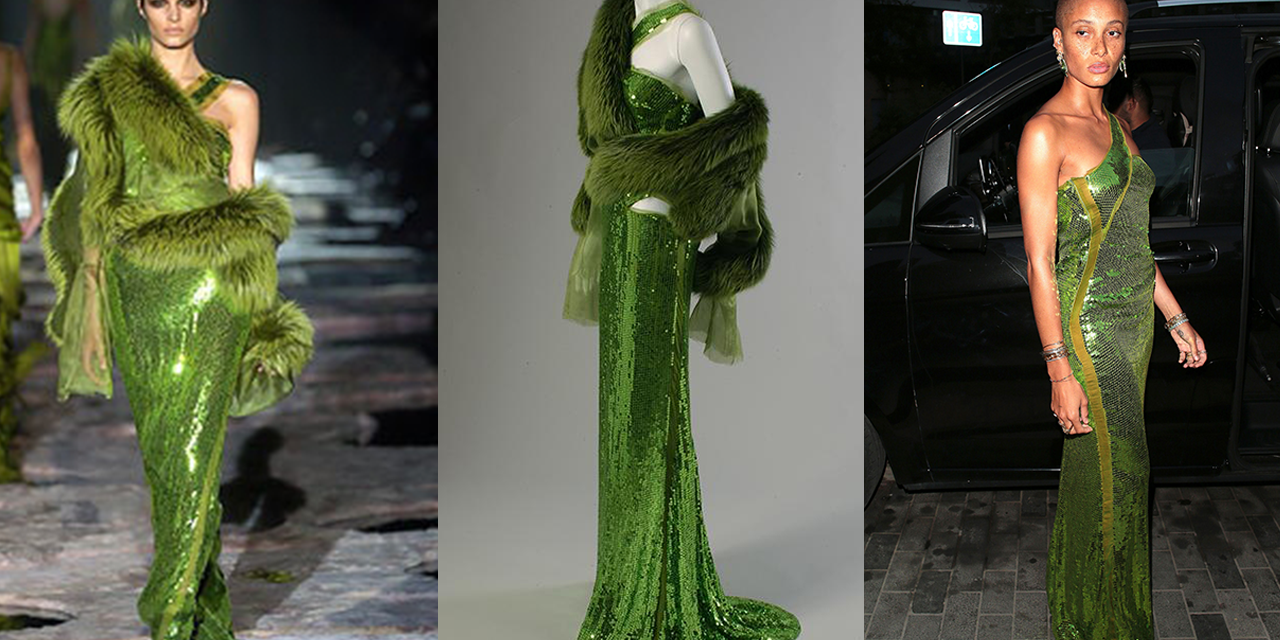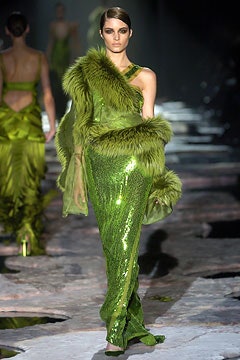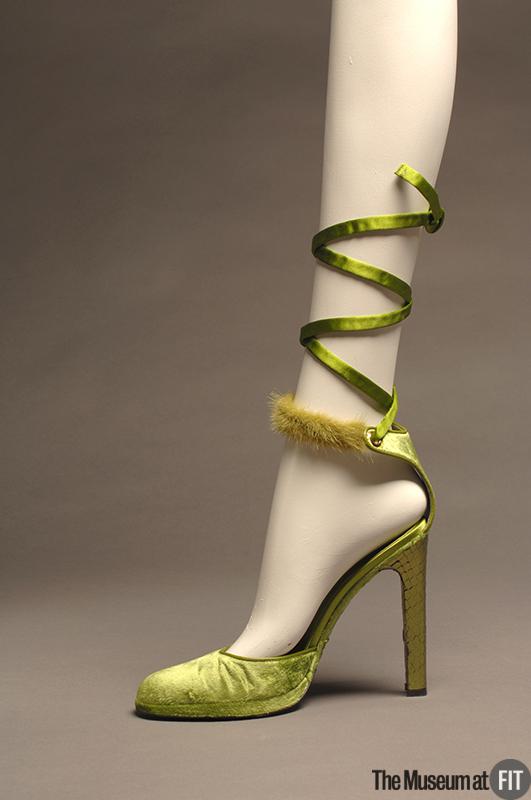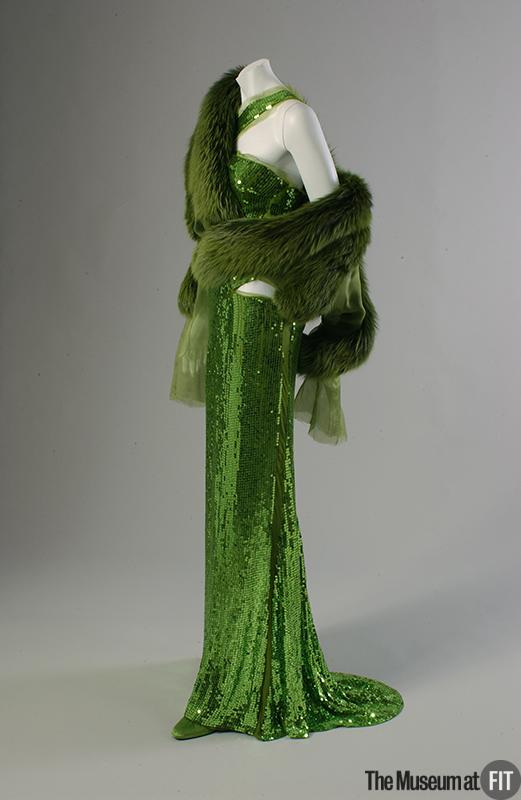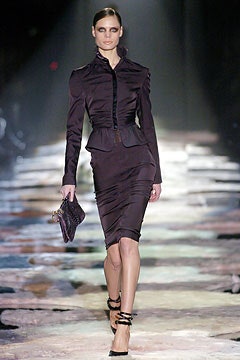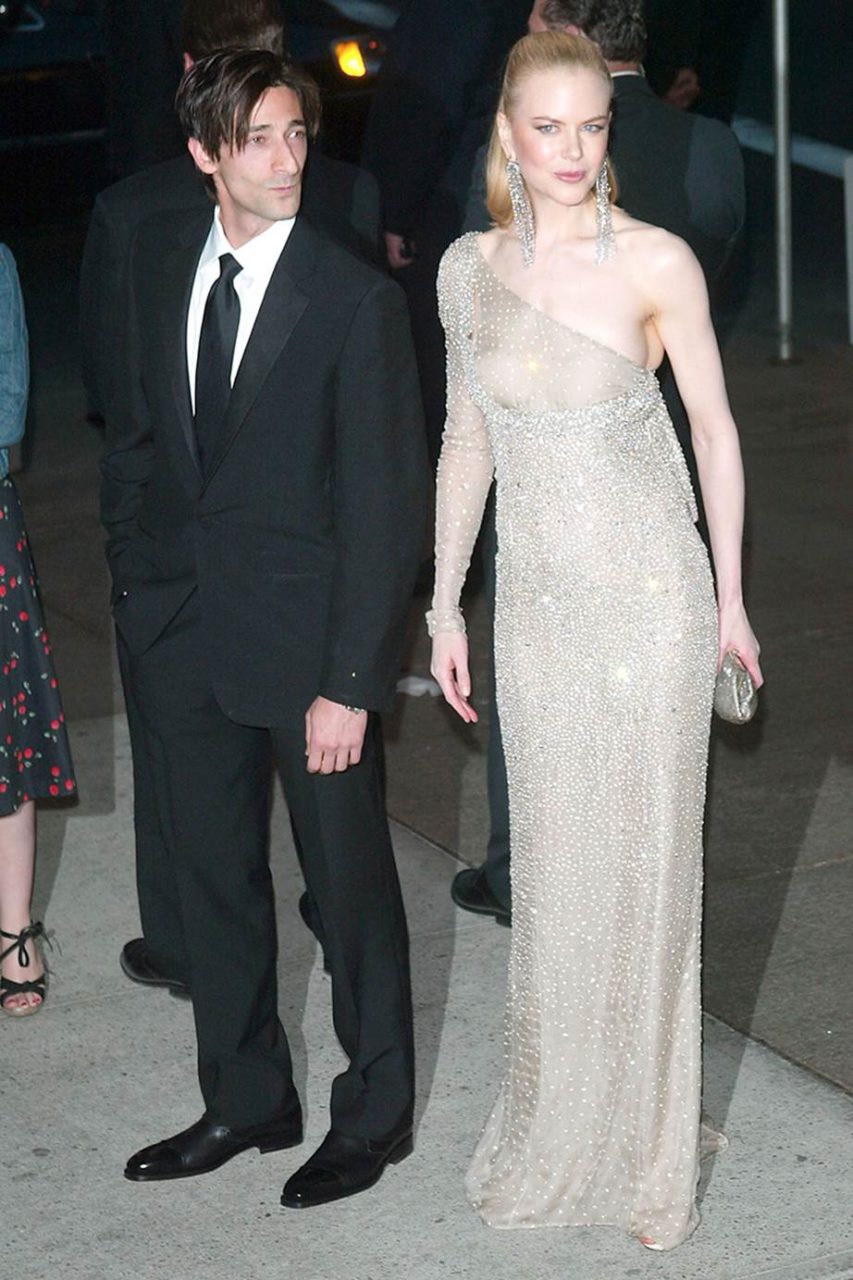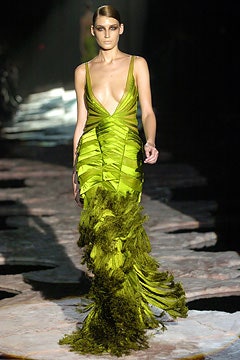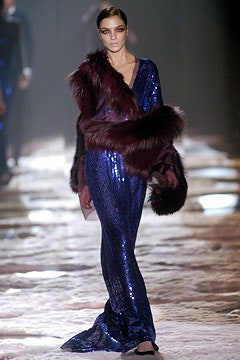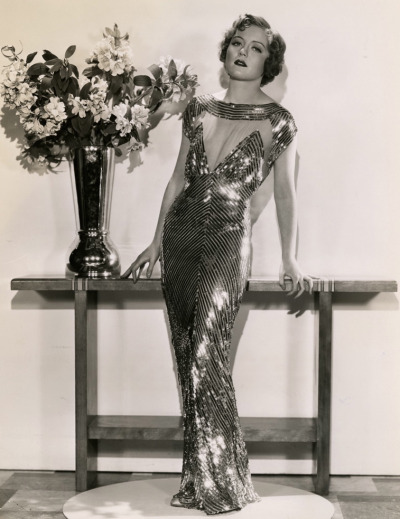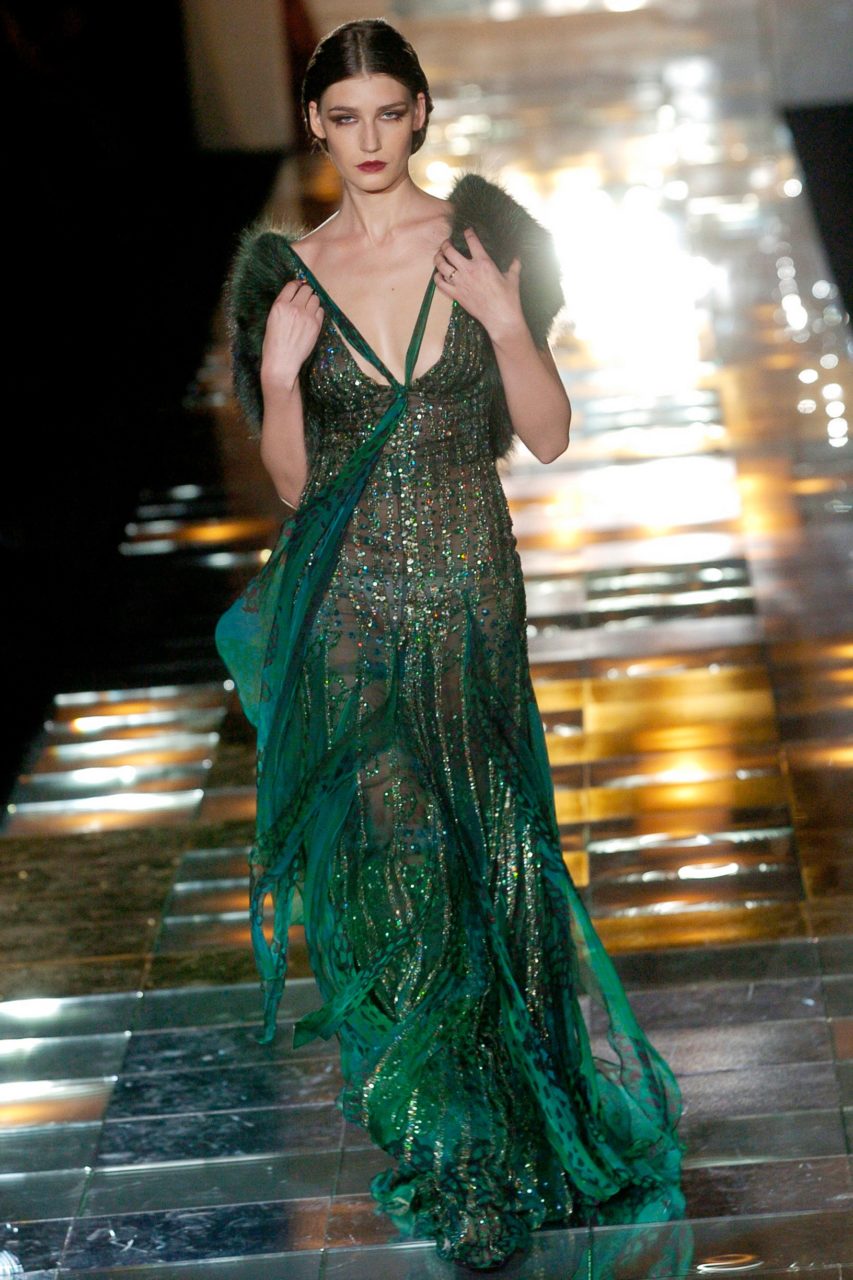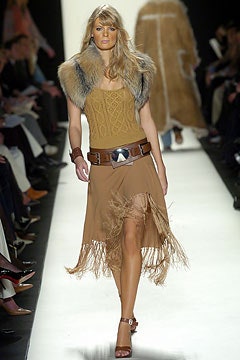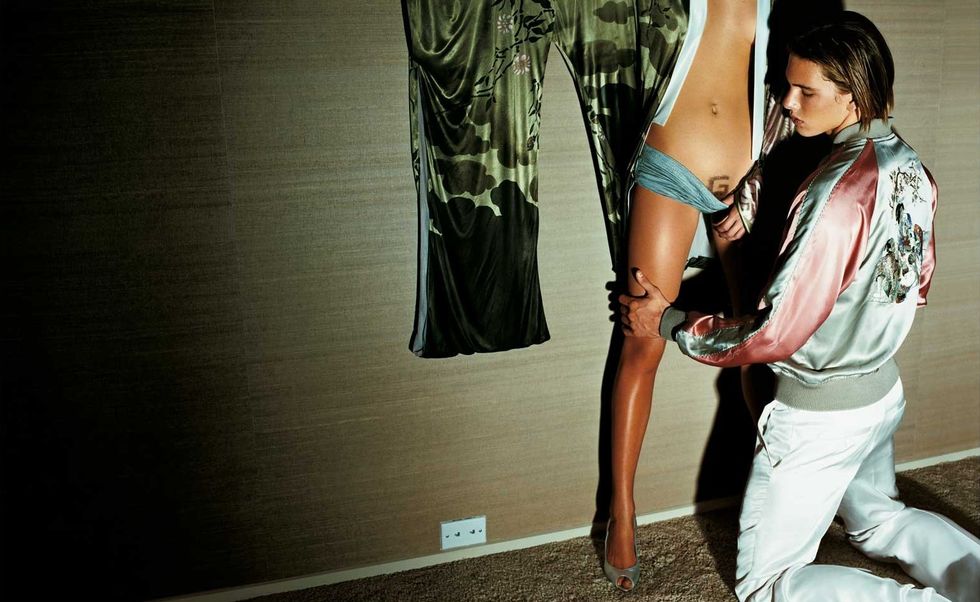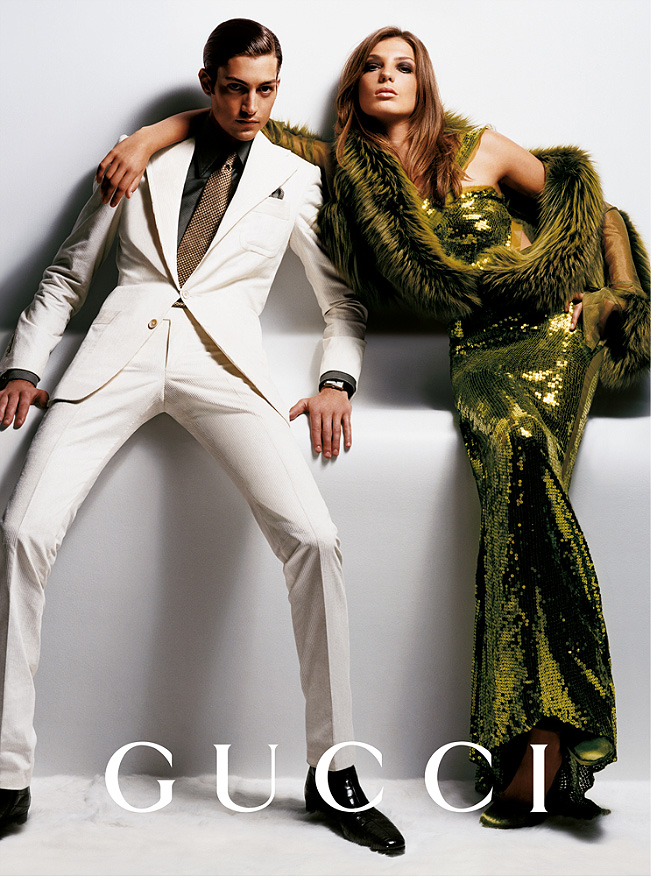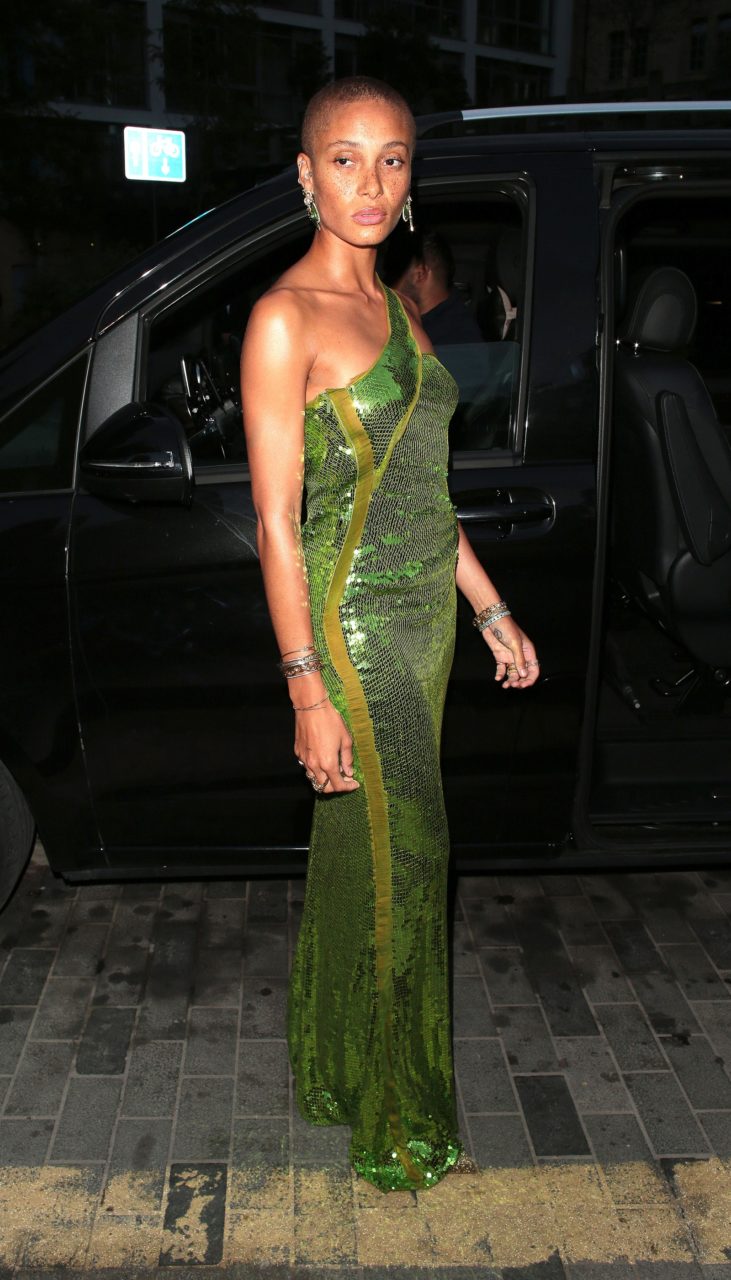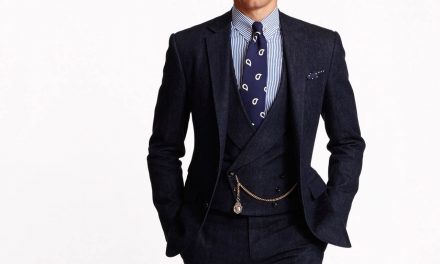This 2004 acid green sequin gown embodies the sex appeal and modern lines that Tom Ford’s designs have been known for throughout his career.
About the Look
Tom Ford’s Fall/Winter 2004 collection for Gucci featured 47 runway looks and debuted in Milan. This acid green, floor-length evening gown and fur wrap ensemble (Fig. 1) appeared two-thirds of the way through the show alongside other slinky, jewel-toned dresses. The sleeveless dress features scattered, sexy cutouts at the waist, hip, and shoulder. Bands of lightweight organza edge the dress, which is covered in chartreuse sequins (Fig. 2). The dress is accessorized with a green, asymmetrical fur wrap, featuring a sheer chiffon sleeve, that wraps around the body but leaves the left shoulder exposed. The look is completed with green velvet shoes with fur detailing, bringing in distinct elements from the gown and wrap (Fig. 3). This ensemble demonstrates Ford’s ability to create evening wear with a seductive spin. As the Museum at FIT notes:
“Tom Ford revived the Gucci label with his unapologetically sexy and often revealing designs. In this example, revealing clothing and a sense of freedom combine to create a confident, sexy look.”
Fig. 1 - Tom Ford (American, 1961-). Green Evening Ensemble, Fall/Winter 2004. Model: Marija Vujovic. Photo: Marcio Madeira. Source: Vogue
Fig. 2 - Tom Ford (American, 1961-). Green Evening Ensemble, 2004. Acid green sequins, chiffon, organza, velvet, and fur. New York: Museum at FIT, 2005.54.1. Gift of Gucci. Source: MFIT
Fig. 3 - Tom Ford (American, 1961-). Green Evening Ensemble, 2004. New York: Museum at FIT, 2005.54.1. Gift of Gucci. Source: MFIT
Tom Ford (American, 1961-). Green Evening Ensemble, 2004. Acid green sequins, chiffon, organza, velvet, and fur. New York: Museum at FIT, 2005.54.1. Gift of Gucci. Source: MFIT
About the context
Gucci and Ford’s relationship was symbiotic; it allowed both parties to grow their names in the fashion industry. In a 2018 article, “Proof that Tom Ford-Era Gucci was Fashion at its Peak”, Harper’s Bazaar describes Ford’s evolution:
“Tom Ford was a relatively unknown designer when he landed the role of creative director at Gucci in 1994. However, his vision saw the historic Firenze label ascend to a fashion industry fixture.”
The 2004 Fall/Winter collection was a tribute to the success that Ford had brought to the brand. The show opened with a model oozing with confidence in an aubergine ensemble (Fig. 4). Sarah Mower from Vogue (Feb. 2004) saw this grand finale to Ford’s time at Gucci as a spectacular recapitulation of his ideas:
“The emotional ending of the Tom Ford era at Gucci was a look back in glamour—a fabulous farewell in which this perfection-obsessed superstar of fashion seized the moment to run his eye over everything he has achieved for the brand, and then do it better. There is no doubt who the Gucci woman is: the embodiment of sexual confidence, burnished to a high gloss and bursting with predatory power. A symbolic figure of the past decade’s hedonistic highs, she spike-heeled her way down a runway carpeted with pink fur, luxuriating in Ford’s aesthetic one last time.”
It was a seductive show that brought in elements from many of Ford’s collections with the fashion house. The highlight of this collection was the eveningwear. Ford was known for show-stopping evening looks for celebrities; it would have been surprising to see anything less in his final collection. Dramatic gowns and dresses walked the runway, each an homage to a previous collection. For example, Ford drew inspiration from the sleek sparkly silhouette of the 2003 Met Gala look he designed for Nicole Kidman (Fig. 5). The look that appeared on the runway directly before the acid green sequin dress was an acid green satin mermaid gown with organza detailing (Fig. 6). Both gowns combined sophisticated detailing with classic silhouettes. Mower singled out the acid-green dress with fur wrap look:
“Ford outdid himself as well with event-making eveningwear. There were slithering sequined mermaid gowns, the ultimate done in a fantastically evil shade of green and wrapped in an arrogant fox-and-chiffon stole.”
Two similar sequin-covered electric blue dresses followed the acid green ones, with the second also adorned with an asymmetrical fur wrap (Fig. 7).
The green sequin-covered gown with cutouts evokes the long, slinky evening dresses of the 1930s like that worn by Nancy Carroll in A Woman Accused (1933) (Fig. 8). This continues a popular trend from the Spring 2004 runways, as Vogue remarked of Alber Elbaz’s Spring 2004 show for Lanvin:
“Elbaz also grasped at the slippery subject of slinky, thirties-era glamour—something that has emerged as a preoccupation of the season.”
The collection had some similarities to the other designers’ fall/winter lines as well. Elie Saab’s Fall 2004 Couture show included 1930s inspired evening looks as well (Fig. 9). Sequins appeared on streamlined evening dresses by Ralph Lauren and Jean-Paul Gautier. Fur wraps were popular accessories appearing on the runways of Louis Vuitton, Caroline Herrera, and Michael Kors (Fig. 10).
Fig. 4 - Tom Ford (American, 1961-). Day Ensemble, Fall/Winter 2004. Model: Adina Fohlin. Photo: Marcio Madeira. Source: Vogue
Fig. 5 - Tom Ford (American, 1961-). Nicole Kidman in Gucci at the 2003 Met Gala, with Adrien Brody, 2003. Source: Harper's Bazaar
Fig. 6 - Tom Ford (American, 1961-). Green Evening Gown, Fall/Winter 2004. Model: Eugenia Volodina. Photo: Marcio Madeira. Source: Vogue
Fig. 7 - Tom Ford (American, 1961-). Blue Evening Gown, Fall/Winter 2004. Model: Mariacarla Boscono. Photo: Marcio Madeira. Source: Vogue
Fig. 8 - Photographer unknown. Nancy Carroll in Woman Accused, ca. 1933. Source: Tumblr
Fig. 9 - Elie Saab (Lebanese, 1964-). Fall 2004 Couture, 2004. Model: Eugenia Volodina. Photo: Marcio Madeira. Source: Vogue
Fig. 10 - Michael Kors (American, 1959-). Day Ensemble, Fall/Winter 2004. Source: Vogue
Compared to other designers, Ford stands out in his use of sex and scandal to promote his brand. In 2019, the popular style publication CR Fashion Book describes Ford’s reputation at Gucci as “the designer [who] infused the brand with an overt sex appeal” (Silver). Ford’s looks for Gucci were often shot in provocative ways by famed photographer Mario Testino. CR Fashion Book describes one such advertisement (Fig. 11):
“Perhaps most famously, one ad showed a nearly nude Carmen Kass showing a male model the “G” she had shaved into her pubic hair. During Ford’s tenure, the term “sex sells” was taken quite literally; Gucci’s boost in sales turned it into a $10 billion fashion superstar” (Silver).
This scandalous advertisement was not the the only one to challenge cultural mores. At the beginning of his tenure at Gucci in 1995, Ford commissioned sexy ads showing bondage-like outfits. The acid green sequined gown was featured by the brand in its 2004 advertisements (Fig. 12) also shot by Testino with a sultry and provocative flair.
The dress–and the 2004 Fall/Winter collection more generally–demonstrate Ford’s evolution as a designer as well as his lasting mark on Gucci’s history.
Fig. 11 - Mario Testino (British, Peruvian, 1954-). Gucci G advertisement, 2003. Source: CR Fashion
Fig. 12 - Mario Testino (British, Peruvian, 1954-). Gucci Fall/Winter advertisement, 2004. Source: Fashion Gone Rogue
Its Afterlife
Vintage fashions from the early 2000s have surged in popularity recently. In 2019, Ford’s green sequined dress was worn by model Adwoa Aboah on the red carpet for the 2019 GQ Men of the Year awards (Fig. 13). In Vogue’s 2019 article, “Adwoa Aboah Makes the Case for Vintage on the Red Carpet”, author Janelle Okwodu writes:
“Aboah and stylist Alexandra Conran modernized the gown by paring things down on the accessories front. Gone was the acid green stole worn on the runway by model Marija Vujovic and in its place were emerald drop earrings and diamond cuffs. By switching the focus from fur to jewels, Conran and Aboah amped up the sexiness while making it feel fresh.”
Ford’s work at Gucci, including this collection, has also been recently showcased at the Gucci Garden museum in Florence, Italy.
Fig. 13 - Tom Ford (American, 1961-). Adwoa Aboah wears Vintage Gucci, September 2019. Source: Vogue
References:
- “Evening Ensemble by Gucci.” The Museum at FIT. Accessed July 10, 2020. https://www.fashiongonerogue.com/wp-content/uploads/2013/10/gucci-fall-2004-campaign3.jpg
- Mower, Sarah. “Fall 2004 Ready-To-Wear Gucci.” Vogue, February 24, 2004. Accessed July 10, 2020. https://www.vogue.com/fashion-shows/fall-2004-ready-to-wear/gucci
- Okwodu, Janelle. “Adwoa Aboah Makes the Case for Vintage on the Red Carpet.” Vogue, September 4, 2019. Accessed July 10, 2020. https://www.vogue.com/vogueworld/article/adwoa-aboah-vintage-red-carpet-tom-ford-for-gucci
- “Proof that Tom Ford-Era Gucci was Fashion at its Peak.” Harper’s Bazaar, August 27, 2018. Accessed July 10, 2020. https://www.harpersbazaar.com.au/fashion/tom-ford-birthday-gucci-17236
- Silver, Dena. “Charting The Evolution of Gucci.” CRFashionBook, March 26, 2019. Accessed July 10, 2020. https://www.crfashionbook.com/fashion/a26934683/evolution-gucci-designer/.
-
Vogue. “Lanvin Spring 2004 Ready-to-Wear Fashion Show.” Accessed August 4, 2020. https://www.vogue.com/fashion-shows/spring-2004-ready-to-wear/lanvin.

